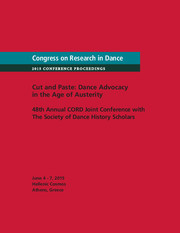No CrossRef data available.
Article contents
Going Native: Ethics and American Cultural Appropriation of Butoh Dance
Published online by Cambridge University Press: 04 January 2013
Abstract
Inspired by an illustration entitled “Traditional Japanese Physique” in an American text on Butoh dance, this paper probes the conception of and relationship to such a body within American Butoh dance. What is this notion of a “Japanese body,” and what are the ethics of appropriating it? How do we talk about the body in a dance form that grew from a specific cultural context but is now considered a global form? I address these questions with reference to “Orientalization” in early American Modern Dance and related practices in contemporary American Butoh. Applying Edward T. Hall's model of cross-cultural communication to dance studies, I discuss ways in which American dancers and dance scholars might approach the Butoh body in nonessentializing terms. This paper is intended to open up conversation about cultural appropriation in artwork and the complexities of Butoh dance as a global practice.
- Type
- Research Article
- Information
- Copyright
- Copyright © The Author(s) 2008


